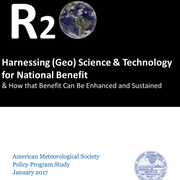Executive Summary
The Nation has much to gain from (1) advancing the geosciences and (2) harnessing those advances to guide decisions and actions with respect to extraction and use of natural resources, building resilience to natural hazards, and protecting the value of Earth’s ecosystem services. This American Meteorological Society policy study examines that second step, and identifies ways and means for more effectively realizing societal benefit. The insights are summarized in a set of findings and recommendations:
Finding 1. The application of new knowledge for societal benefit is pivotal to the future of nations and global society. Such application can be accelerated. This represents a significant opportunity for the United States.
Recommendation 1. The nation—government at all levels, private enterprise, and academia—should give more attention and priority to this opportunity, and be more disciplined in its execution.
Finding 2. Innovation is not a one-way process leading from science and technology to societal benefit, but a two-way process, in which societal needs also often motivate and direct innovation. Similarly, innovation has more of an iterative, ongoing chicken–egg character; it doesn’t feature any well-defined beginning and end.
Recommendation 2. Scientists and users should therefore see themselves more as co-producers of innovation, and invest more in ongoing, close communication and collaboration.
Finding 3. Infrastructure and capacity building are needed to support this.
Recommendation 3. Government, private enterprise, and academia should develop ways and means to provide sustained funding for science application as well as science per se. But the need goes beyond budgets. Institutions need to plan, organize, and measure the transition from science to application, identify means for breaking down transition into multiple, manageable, reversible smaller steps versus relying on major leaps from basic research to widespread adoption and use. They need to identify tailored positions, career tracks, recognition, and other incentives for applied work. Support for application needs to be both top-down and grassroots and allow for both specialization and for flexibility.
Finding 4. Innovative methods and techniques exist for accelerating and sustaining application, but are underutilized.
Recommendation 4. Institutions should explore and make broader use of tools and approaches such as test beds/rapid prototyping, pilot programs, big data/ data analytics, and crowdsourcing.
Finding 5. Both the means and the benefits of application have a strong private- sector dimension. The private sector, which in the United States amounts to 90% of the labor force, is unsurprisingly a primary means through which advances in science and technology ultimately lead to societal benefit. Because the U.S. private sector is increasingly embedded in a global economy, the benefits of application should be worldwide. However, two centuries of U.S. culture and regulatory framework have established boundaries separating the public and private sectors that are better equipped to deal with domestic rather than international aspects of science application.
Recommendation 5. Policy makers and business leaders should pay more attention to ways and means for public and private sectors to collaborate in innovation while maintaining the regulatory framework that provides for a level playing field, fair competition, and other social goals. In evaluating the cost– benefits (broadly construed) of science application, policy makers and business alike should look not just to domestic benefits but also to the international benefits and opportunities.
Finding 6. Sustaining application requires a scientifically literate public that holds its leaders and institutions accountable for continuing innovation.
Recommendation 6. The nation should place more emphasis on STEM education, both to provide the professionals needed by government, business, and academia to advance and apply science and technology, and to ensure the larger population understands the strategic importance of innovation, stays abreast of progress, and holds leaders accountable for sustained improvement.
